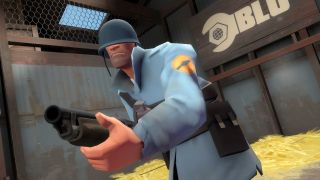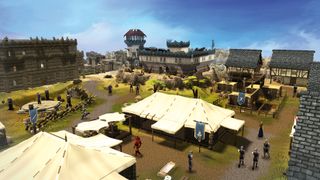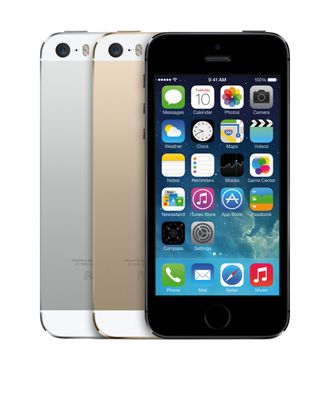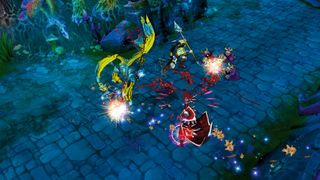From floppy disks to freeware: the history of F2P gaming
The history of F2P is paved with good intentions

The PC has a long history of its users getting stuff for nothing at all. Way back in the 1980s, we had shareware. It was an almost viral method of transmitting data via copied 3.5-inch floppy disks that originated in the programmer's bedroom and spread via cover-mounted discs and friends' computers. It was crude and rudimentary, but the promise of free software ensured that games – such as Doom and Commander Keen – could spread like wildfire.
Fast-forward some 30 years and we're still experiencing the same phenomenon. Demos and cover-mounted discs have had their day, but free-to-play software has stepped into the breach, giving players something for (almost) nothing. And despite feeling like a relatively new movement, free-to-play games have actually been around for at least a decade. But where did they come from?
Back in the early 2000s, internet piracy was at its most nascent, but gaining traction. Downloading an MP3 via Soulseek or Kazaa was common, but the large file size of games represented a bigger problem for pirates. Enter BitTorrent, the file-sharing program that allowed large pieces of software to be shared via peer-to-peer networks. Piracy was no longer about burning a CD for your mates; it was a global phenomenon, and it had just got a lot harder to trace.

Simultaneously, the internet was exploding into the mainstream and massively-multiplayer titles were exploiting the extra bits of bandwidth. Among the experimenters in the new genre was Jagex, the builder of RuneScape. "At the beginning it was really indie," explains the game's executive producer Phil Mansell. "They were just doing it because they loved it, and it connected with the players and just grew and grew."
RuneScape was initially funded purely by ads. "Back during the dotcom boom, advertising revenues were amazing," says Mansell. "You didn't have to have many users – you could make loads of money."
Boom to bust
Of course, then the dotcom bubble burst – but in the residue was a truly useful global network of computers talking to one another. Broadband speeds were kicking in, which meant that online gaming could be based on more complex packets of information, and gamers didn't have to wait the majority of their lifetimes for a 1GB client to download.
"After the dotcom crash, RuneScape changed to a subscription 'layer'," says Mansell. "You could be a premium member and get loads and loads more stuff." Massively multiplayer games like PlanetSide, EVE Online and World of Warcraft followed RuneScape's lead, while free MMOs simmered gently in the background. At the time, these were aimed at kids and included Furcadia and MapleStory, both of which are still running today.
Get daily insight, inspiration and deals in your inbox
Get the hottest deals available in your inbox plus news, reviews, opinion, analysis and more from the TechRadar team.

Then there was the release of smartphones, in particular Apple's iPhone launched in 2007. Smartphone gaming pushed free-to-play into the mainstream. These devices packed far more powerful components than the limited handsets that preceded them, but their small scale meant that customers were less likely to spend big bucks on console-style titles, preferring to dish out a dollar – or less – for a simple game that they could play on the train.
Just four years after its release, 65 per cent of game revenue in Apple's App Store came from in-app purchases, with consumers spending an average of $14 according to analyst Flurry. It worked on tiny devices in people's pockets, so there was no reason why it wouldn't translate to the PC.
The F2P switch
Lord of the Rings, Age of Conan and Dungeons & Dragons Online all switched to a free-to-play model within a few years – and the fact that they are all still up and running suggests that it paid off. Conan's revenues increased dramatically when it went free-to-play. "The activity levels on the servers are booming with a fourfold increase in players during July," said Funcom CEO Trond Arne Aas. "We more than doubled revenue generated from the game, and we have experienced a positive development in subscriber numbers."

All this has happened alongside a new generation of games that embraced the free-to-play model from the ground up. League of Legends is the most notable example – the multiplayer online battle arena (MOBA) game generated $624 million in 2013. Valve's MOBA Dota 2 also employed free-to-play, and it has become one of the company's biggest titles.
RuneScape adapted its model in 2012 to embrace free-to-play. "A few years ago we added optional microtransactions," says Mansell, "so if you wanted to pay a bit more to get more stuff, like cosmetic gear, or play some games of chance to get some extra items, you could.
We can have all the benefits of free-to-play, because there are lots of people coming in the door, trying it out, seeing if they like it, with very low commitment and low barriers to entry. But we've got the benefits of subscriptions, so if people really like it and they're really into it they can pay $8 a month for our service, which is pretty good value compared to the other ones – and you can get absolutely tons of content and something new every week too."
Transactions of half a penny for a pair of in-game boots would probably bring the world banking system to its knees, so gamers are encouraged to buy in-game credits up front. These often carry an awkward exchange rate, such as 1,380 League of Legends Riot Points for $10.
Other games' systems work a little more transparently. Team Fortress 2 and Dota 2 both invite you to add funds to your Steam Wallet before spending them in-game, but items are priced in real-world terms.
Micro minority
However these payments are badged up, though, it really is only the minority of gamers who pay up for these extras. App testing firm Swrve has revealed that half of free-to-play games' in-app purchases came from 0.15 per cent of players, and only 1.5 per cent spend any money at all. Almost all are playing for free – so why would a developer want so many freeloaders cramming their servers?
The simple answer is scale. Free-to-play games aren't limited by the need to make and distribute physical media, so they can be downloaded millions of times all over the world. You'll also notice that most have social networking features baked in, so that gamers who've discovered the title will share how great it is with their friends.

Given the issues many have with free-to-play games (particularly that they use the word free), it is no wonder the category has been the subject of an Office of Fair Trading investigation in the UK, resulting in some sensible guidelines: microtransactions explicitly require account holder permission, and hidden costs must be declared upfront. The European Commission is also launching an investigation into free-to-play, with a focus on use of the word 'free', as well as children's access to in-game spending and daddy's Amex card.
Having such guidelines does mean some developers are finally changing their business model. RuneScape – one of the very first free-to-play titles – has found a way to make itself truly free.
"The most recent change we've made is with bonds, which you can trade in-game with other players," says Mansell. "People can pay for the game through their trades, so it's now possible to get all our premium in-game services without ever spending any real-life money. We've got almost every angle."
